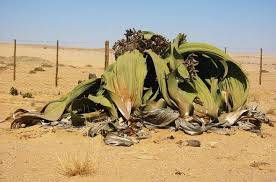
Welwitschia belongs to the group of gymnosperm plants. Because of their unique properties, botanists classified Welwitschia into a special family (called Welwitschiaceae) that does not contain any other species. Welwitschia occurs only in the Namib Desert in Namibia and Angola. This unusual plant is sometimes called the “living fossil” because it has existed on the planet for millions of years. Welwitschia is susceptible to fungal diseases and is often attacked by desert animals. Fortunately, this plant is still abundant in the wild and is not on the endangered plant species list.
Welwitschia or Welwitschia mirabilis is known as one of the oldest living plants.
Welwitschia consists of stem, two leaves and root. This plant usually grows 20 inches in height and 6.6 feet in length. Larger plants are often seen in areas where rainfalls are rare.
It can be called a “living fossil”.
Largest recorded specimen managed to reach 6 feet in height and 28 feet in length.
The plant is mainly found in the deserts of Namibia.
Welwitschia has short but very strong, wooden stem without branches. Stem is hollow and has the shape of inverted cone.
It is named after the discoverer, Dr. Friedrich Welwitsch.
Welwitschia develops two leaves which grow continually throughout the whole life of a plant. Leaves are broad, leathery and shaped like belt.
The plant is locally called “long haired thing”.
Leaves become frayed and look like a bunch of worn-out ribbons after decades of exposure to harsh weather conditions, strong wind and constant abrasion of the sandy ground.
Stomata occur on both leaf surfaces.
Welwitschia has long taproot that is able to reach water hidden deeply underground. Due to lack of rain and available water, plant absorbs majority of water from the fog and dew.
The woody stem widens with age to become a concave disc up to a meter across, from which grow small ramified branch systems that serve only to bare pollen and seed cones.
Welwitschia is dioecious plant which means that each plant develops either male or female reproductive organs. Male plant produces smaller salmon-colored cones. Female plant produces larger bluish-green cones.
The branched reproductive shoots arise near the leaf bases.
Flowering takes place from summer to autumn. Both male and female plants produce large quantities of nectar which attracts wasps, tree bugs and flies and ensures pollination.
Red pollen cones, resembling those of Ephedra, appear in groups of 2-3 on each branch.
Female cones reach maturity 9 months after fertilization. Degradation of female cones results in release of seed. Seed has wings which facilitate dispersal by wind.
Normally, only one seed develops within each cone and is dispersed by wind.
Seed can remain viable (able to germinate) during extended period of time. Heavy rains are required for successful germination. Only few seed will germinate, the rest will be lost due to fungal diseases and because they are part of a diet of desert animals.
Welwitschia leaves are the longest-lived in the plant kingdom, they are evergreen, a single pair and generally broad and flat.
Antelopes and rhinos eat leaves and soft parts of the stem to obtain water. Damaged plant usually manages to recuperate.
The broadest unbroken leaf measures 179 cm.
Welwitschia is also known as “onion of desert” because indigenous people eat core of the plant. Welwitschia can be use either raw or as a part of cooked meal.
The leaves are on average 1.4 cm thick.
Welwitschia is very old plant. It originates from Jurassic period when the gymnosperms were the most dominant plants on the Earth.
The leaves that lay on the sand surface also prevent wind erosion.
Even though it looks like a tough task, welwitschia can be easily cultivated as a houseplant.
Even under gale force conditions the broad leaves remain rigid and immobile.
Welwitschia usually lives from 300 to 500 years in the wild. Some plants can survive over 2000 years.
Unlike other plants the stomata is open under foggy conditions and closes when it is hotter. This ensures that no water is evaporated during the heat of the day.









